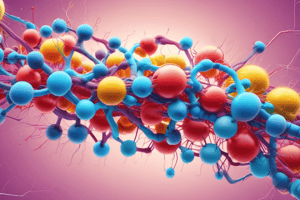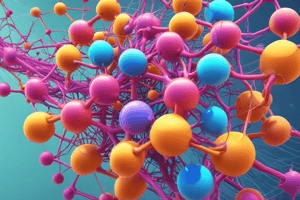Podcast
Questions and Answers
What is the role of phosphofructokinase (PFK-1) in the regulation of glycolysis?
What is the role of phosphofructokinase (PFK-1) in the regulation of glycolysis?
- PFK-1 catalyzes the irreversible phosphorylation of fructose-6-phosphate to fructose-1,6-bisphosphate, which is a rate-limiting step in glycolysis.
- PFK-1 is allosterically inhibited by ATP, which helps to slow down glycolysis when energy levels are high.
- PFK-1 is allosterically activated by AMP, which helps to speed up glycolysis when energy levels are low.
- All of the above. (correct)
What is the role of adenylate kinase in the regulation of glycolysis?
What is the role of adenylate kinase in the regulation of glycolysis?
- Adenylate kinase has no role in the regulation of glycolysis.
- Adenylate kinase converts ATP into ADP and ADP, which helps to maintain the ATP/ADP ratio.
- Adenylate kinase converts ADP into ATP and AMP, which helps to maintain the ATP/ADP ratio. (correct)
- Adenylate kinase converts AMP into ATP and ADP, which helps to maintain the ATP/ADP ratio.
How does the rate of ATP hydrolysis affect the rate of glycolysis?
How does the rate of ATP hydrolysis affect the rate of glycolysis?
- The rate of ATP hydrolysis has no effect on the rate of glycolysis.
- The rate of ATP hydrolysis is inversely proportional to the rate of glycolysis.
- The rate of ATP hydrolysis is directly proportional to the rate of glycolysis.
- The rate of ATP hydrolysis is set to match the rate of ATP synthesis, which determines the rate of glycolysis. (correct)
What is the role of hormonal regulation in the control of glycolytic flux in hepatocytes?
What is the role of hormonal regulation in the control of glycolytic flux in hepatocytes?
What is the net result of the conversion of one mole of glucose to two moles of pyruvate in glycolysis?
What is the net result of the conversion of one mole of glucose to two moles of pyruvate in glycolysis?
What is the primary function of the oxidative decarboxylation of pyruvate?
What is the primary function of the oxidative decarboxylation of pyruvate?
What is the primary role of 2,3-BPG in red blood cells?
What is the primary role of 2,3-BPG in red blood cells?
Which of the following is a key step in the regulation of glycolysis?
Which of the following is a key step in the regulation of glycolysis?
In the clinical case, which of the following is the most likely cause of the patient's hemolytic anemia?
In the clinical case, which of the following is the most likely cause of the patient's hemolytic anemia?
What is the significance of the elevated bilirubin level in the patient's blood?
What is the significance of the elevated bilirubin level in the patient's blood?
How does the patient's red blood cell metabolite concentrations compare to the control?
How does the patient's red blood cell metabolite concentrations compare to the control?
Which hormone is most likely to be involved in the regulation of glycolysis in the patient's case?
Which hormone is most likely to be involved in the regulation of glycolysis in the patient's case?
Which of the following pathways is primarily responsible for producing ATP during aerobic respiration?
Which of the following pathways is primarily responsible for producing ATP during aerobic respiration?
What is the primary role of the pyruvate dehydrogenase (PDH) reaction in cellular metabolism?
What is the primary role of the pyruvate dehydrogenase (PDH) reaction in cellular metabolism?
Which of the following statements about the regulation of glycolysis is correct?
Which of the following statements about the regulation of glycolysis is correct?
Which of the following statements accurately describes the role of hormones in regulating metabolism?
Which of the following statements accurately describes the role of hormones in regulating metabolism?
Which of the following statements is true regarding the production and utilization of ATP in cells?
Which of the following statements is true regarding the production and utilization of ATP in cells?
Which of the following is a common nucleophile in biochemical reactions?
Which of the following is a common nucleophile in biochemical reactions?
Flashcards are hidden until you start studying




